CD8beta/CD28 expression defines functionally distinct populations of peripheral blood T lymphocytes
- PMID: 12930358
- PMCID: PMC1808803
- DOI: 10.1046/j.1365-2249.2003.02226.x
CD8beta/CD28 expression defines functionally distinct populations of peripheral blood T lymphocytes
Abstract
Peripheral blood CD8+ T lymphocytes generally express the CD8 coreceptor as an alphabeta heterodimer. On these cells, the CD8beta chain is present either at high (CD8betahigh) or low density (CD8betalow). CD8betahigh cells are CD28+, whereas CD8betalow cells are CD28+ or CD28-. Therefore, three subpopulations of CD8+ T cells can be described: (i) CD8betahighCD28+ (ii) CD8betalowCD28+, and (iii) CD8betalowCD28- cells. Phenotypic and functional characterization of these CD8+ T cell subsets revealed significant differences. CD8betahighCD28+ cells predominantly express CD45RA. In contrast, CD8betalowCD28+ cells frequently express CD45R0 and the activating NK receptor CD161. CD8betalowCD28- cells frequently revert to the CD45RA phenotype. In addition, these cells express CD16, CD56, CD94, and the killer-inhibitory receptors NKB1 and CD158a. Intracellular IL-2 was frequently detected in CD8betahighCD28+ cells and CD8betalowCD28+ cells, but not CD8betalowCD28- cells. CD8betalowCD28+ cells and CD8betalowCD28- cells frequently stained positive for IFN-gamma. In addition, these cells contain intracellular perforin and granzyme A. Expression of Fas (CD95) as well as susceptibility to apoptosis is markedly increased in CD8betalowCD28+ and CD8betalowCD28- cells as compared to CD8betahighCD28+ cells. In vitro activation of peripheral blood lymphocytes triggered expansion of CD8betahighCD28+ cells as well as a development into CD8betalowCD28+ and CD8betalowCD28- cells. Similarly, activation of CD8betahighCD28+ cord blood cells resulted in the appearance of CD8betalowCD28+ and CD8betalowCD28- cells. These data suggest that CD8betahighCD28+ cells can differentiate into CD8betalowCD28+ and CD8betalowCD28- cells upon TCR stimulation. Therefore, the CD8beta/CD28 subsets in peripheral blood may reflect distinct stages of post-thymic CD8+T cell development.
Figures
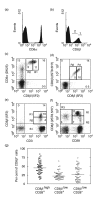
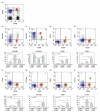
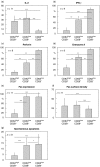
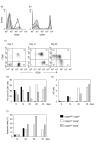
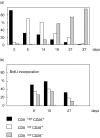
Similar articles
-
CD11b expression identifies CD8+CD28+ T lymphocytes with phenotype and function of both naive/memory and effector cells.J Immunol. 2001 Jan 15;166(2):900-7. doi: 10.4049/jimmunol.166.2.900. J Immunol. 2001. PMID: 11145666
-
Primary defect in CD8+ lymphocytes in the antibody deficiency disease (common variable immunodeficiency): abnormalities in intracellular production of interferon-gamma (IFN-gamma) in CD28+ ('cytotoxic') and CD28- ('suppressor') CD8+ subsets.Clin Exp Immunol. 1998 Jan;111(1):70-5. doi: 10.1046/j.1365-2249.1998.00479.x. Clin Exp Immunol. 1998. PMID: 9472663 Free PMC article.
-
Peripheral human CD8(+)CD28(+)T lymphocytes give rise to CD28(-)progeny, but IL-4 prevents loss of CD28 expression.Int Immunol. 1999 Aug;11(8):1327-36. doi: 10.1093/intimm/11.8.1327. Int Immunol. 1999. PMID: 10421790
-
Porcine T lymphocytes and NK cells--an update.Dev Comp Immunol. 2009 Mar;33(3):310-20. doi: 10.1016/j.dci.2008.06.003. Epub 2008 Jul 2. Dev Comp Immunol. 2009. PMID: 18601948 Review.
-
Molecular basis for checkpoints in the CD8 T cell response: tolerance versus activation.Semin Immunol. 2007 Jun;19(3):153-61. doi: 10.1016/j.smim.2007.02.007. Epub 2007 Mar 26. Semin Immunol. 2007. PMID: 17382557 Free PMC article. Review.
Cited by
-
CD45RA, CD8β, and IFNγ Are Potential Immune Biomarkers of Human Cognitive Function.Front Immunol. 2020 Nov 25;11:592656. doi: 10.3389/fimmu.2020.592656. eCollection 2020. Front Immunol. 2020. PMID: 33324408 Free PMC article.
-
A unique population of effector memory lymphocytes identified by CD146 having a distinct immunophenotypic and genomic profile.BMC Immunol. 2007 Nov 13;8:29. doi: 10.1186/1471-2172-8-29. BMC Immunol. 2007. PMID: 17999761 Free PMC article.
-
Human invariant natural killer T cells: implications for immunotherapy.Int J Hematol. 2009 Sep;90(2):137-142. doi: 10.1007/s12185-009-0379-1. Epub 2009 Jul 29. Int J Hematol. 2009. PMID: 19639273 Review.
-
CD8αα Expression Marks Terminally Differentiated Human CD8+ T Cells Expanded in Chronic Viral Infection.Front Immunol. 2013 Aug 6;4:223. doi: 10.3389/fimmu.2013.00223. eCollection 2013. Front Immunol. 2013. PMID: 23964274 Free PMC article.
-
Circulating activated and effector memory T cells are associated with calcification and clonal expansions in bicuspid and tricuspid valves of calcific aortic stenosis.J Immunol. 2011 Jul 15;187(2):1006-14. doi: 10.4049/jimmunol.1003521. Epub 2011 Jun 15. J Immunol. 2011. PMID: 21677140 Free PMC article.
References
-
- Littman DR, Thomas Y, Maddon PJ, Chess L, Axel R. The isolation and sequence of the gene encoding T8: a molecule defining functional classes of T lymphocytes. Cell. 1985;40:237–46. - PubMed
-
- Liaw CW, Zamoyska R, Parnes JR. Structure, sequence, and polymorphism of the Lyt-2 T cell differentiation antigen gene. J Immunol. 1986;137:1037–43. - PubMed
-
- Renard V, Delon J, Luescher IF, Malissen B, Vivier E, Trautmann A. The CD8 beta polypeptide is required for the recognition of an altered peptide ligand as an agonist. Eur J Immunol. 1996;26:2999–3007. - PubMed
Publication types
MeSH terms
Substances
LinkOut - more resources
Full Text Sources
Research Materials
Miscellaneous

